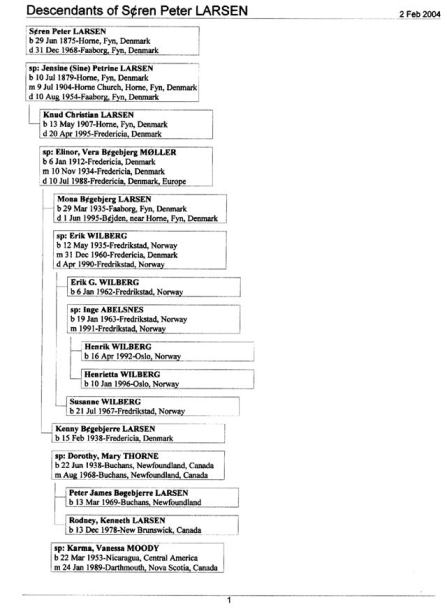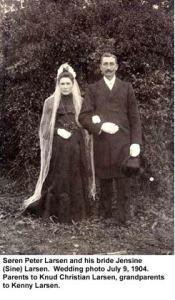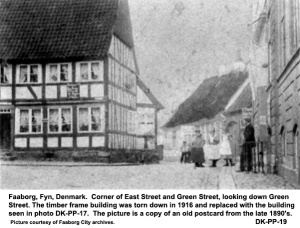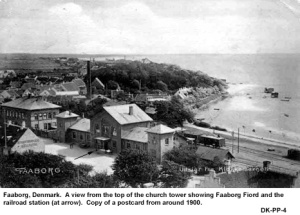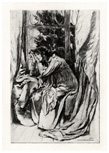My Grandfather
Søren Peter Larsen June 29, 1875 – December 31, 1968
My Grandmother
Jensine Petrine Larsen July 10, 1879 – August 10, 1954
Foreword
I don’t suppose I’m any different than millions of other people when I say that I have a special place in my heart where the memories of my grandparents live. It is a sad misfortune for a child not to have known his or her grandparents, for more often than not; they have a deep fountain of love, from which they shower their grandchildren in unending measures. It is a special kind of undemanding, unselfish love that creates precious memories and a happy childhood.
Few people have ever had a greater influence on my life than my paternal and maternal grandparents. They installed in me a sense of what was needed to survive in life and become a respected member of the society I was to spend my life in. Good manners and morals were part of everyday life for them and they made sure I understood the value of these qualities. I can’t say that I succeeded in upholding all the virtues they taught me, but certainly enough to maintain the respect of the majority of people I came in contact with during my life.
The picture of my paternal grandparents I’m about to paint, is meant to show two people who came from humble origins, but who fought and struggled to rid themselves of the yoke of serfdom their ancestors had lived through. With hard work and diligence and in spite of two world wars and the great depression they succeeded in lifting themselves above poverty.
It is with great pleasure and a deep sense of gratitude that I dedicate these pages to them, but it is also with a sense of obligation, that I write these pages, for I’m the last person still alive who can give an account of a part of their lives.
Kenny B. Larsen, January 2004
Both my paternal grandparents were born in the little village of Horne, shown in the photo above, located on the Island of Fyn, Denmark. Grandfather was the fourth and youngest child of Knud Larsen and his wife Maren Jensen Fløjborg. Knud was born in Bjerne, near Horne on June 15, 1845. Peter had a brother and two sisters plus a half bother and half-sister, born by Maren Jensen Fløjborg, before she married Knud.
Peter Larsen’s brothers and sisters
Jens Peder Knudsen, born 1856
Anne Jensen Fløjborg, born 1859 (1)
Marie Kirstine Larsen, born 1867
Niels Carl Larsen, born 1869
Hanne Henrietta Larsen, born 1873
Jens immigrated to America within a year or two of Peter’s birth in 1875. He died in Texas, childless. Anne Jensen began working on Hvedholm Manor in 1874, married Lars Christian Nielsen in 1879 and immigrated to USA in 1880. Marie Kirstine Larsen followed in her half brother and sister’s footsteps and left for America sometime before 1890, so Peter only got to know his brother Niels and sister Hanne real well for they stayed in Denmark all their lives.
The earliest years of his life are hidden in the mist of time, but a couple of photos of the house he was born in have survived and it is typical of the type of timber frame cottages that existed in the area in the 1800s. His father was a farm labourer and worked all his life (both him and his wife) on Steensgaarden, one of the several large, main farms that belonged to Hvedholm Manorial. The best photo of Peter Larsen’s birthplace can be seen in the next photo that shows his parents outside the house. It was taken sometime between 1895 and 1900 in the late fall.
Peter Larsen’s birthplace. The house was located in Horne Lillemark, a short distance outside the village of Horne. Standing outside are his parents, Knud and Maren Larsen. Photo from about 1900
 Above is a later picture of the house
Above is a later picture of the house
In those days, it was normal for all children living in the rural areas to begin working at the age of fourteen. Just where he worked is unknown, up until he was a young man. In 1898, he was drafted into the Danish army and because of his height and powerful built; he was chosen to serve in The Royal Danish Guards. He was immensely proud of this and remained a member and flag bearer of the Association of old Royal Guards for the rest of his life. In Copenhagen he became exposed to a very different way of life, much more sophisticated than what he was accustomed to. It was no doubt this experience that encouraged him to break with the past and leave the rural, poorly paid hard work and misery he was born into.
I remember grandfather telling me that he for a number of years had worked as a wagon driver for a gristmill called Horne West Mill. This was most likely after he returned from his military service in 1898. In 1903, a photo of the mill was taken and it can readily be assumed it was while working for this mill that he met my grandmother, who was caring for the miller’s children. Peter and his beloved Sine (nickname for Jensine) were married July 9, 1904 in Horne Church. They were both as poor as poor can be, but that was not untypical of that generation. People got by with little and lived happy lives despite what to us today must seem to be grinding poverty. My father told me quite a bit about life back in those days and said he had a very happy childhood, but money was scarce and people were poorly paid for their labour.
It’s quite certain that Peter continued working at the mill for some years after he married, up until 1909, when he became a delivery driver for Sydfyns Brewery. Their only son, my father Knud Christian Larsen, was born in 1907 and he never went to school in Horne, but rather in the town of Fåborg, where they moved to before he reached school age. After my grandparents were married, they rented a place in a triplex timber frame house in a place called Horne Lillegyden, a couple of kilometres from Horne village. Here they lived till about 1912, at which time they moved to the town of Fåborg
My grandmother was also born in Horne, July 10, 1979. She was one of six children born to Christen Larsen (born 1837-Horne) and Karen Madsen (born 1837 in Gummerup Christen was a butcher, but the family was very poor. A single photo of them has survived. The photo was taken in 1906, in Horne, when they both were 69 years old. The last name of both my paternal and maternal grandparents were thus ”Larsen”
Children of Christen and Karen
Lauritz Andreas Larsen, born 1866,( immigrated to Australia
Maren Caroline Larsen, born 1868
Martine Larsen, born 1874
Mads Marius Larsen, born 1877
Jensine (Sine) Petrine Larsen, born 1879 (my grandmother)
Christine Larsen, born 1882
Of her 2 brothers and three sisters, only Lauritz Andreas Larsen immigrated. He went to Australia in 1890, married an English girl, but died childless in 1949 in Cooksville, NSW. Maren Caroline married and settled in Copenhagen; Martine married a man (Nielsen) from Jutland and went to live in Odense, north of Fåborg. She had 13 children, of which 10 survived. Mads Marius Larsen and Christine Larsen both married and stayed in Horne all their lives. Mads became a butcher, following in his father’s footsteps and became a well know and respected resident in the area. Christine married Jacob Andreas Madsen, a fisherman and had two daughters. They are, of course, all dead now, but I was fortunate to get to know most of these, my great aunts and uncles. I may write what I know about them later.
Grandmother Sine was a pretty girl in her youth and quite popular amongst the bachelors, according to grandfather. I know for a fact that he was quite the”ladies man”, and knew a nice filly when he saw one
Other than the fact that Sine worked for the miller on Horne West Mill in 1903, I know nothing of her childhood years. A few photos of her from her young years have survived, one from 1897, when she was 18 years old and one from 1901. Both were taken in a photo studio in Fåborg.
The earliest time I remember my grandparents begins around 1943, when I was five years old and continues right through my childhood years and part of my youth. What happened in their lives during the years before that is what I can remember them telling me and certainly also what my father told me about his childhood home in Fåborg.
It may be worthwhile to illustrate what the town looked like around the turn of the 19th century, just before they moved from Horne to Fåborg. I found several photos (old postcards) posted on an Internet site, which shows a glimpse of this long bygone era. In 1916, a three-story building was constructed at East Street 43, replacing a very old and quite beautiful timber frame building (photo below)
Other views of Faaborg from that time are worth including here, since many of the old buildings still existed when I was a boy and spending my summer holidays there.
The following two are taken from the belfry, the old bell tower dating back to the 14th century, and gives a good view over the city, as it looked around 1900.
The photo above shows a joyful grandmother holding me, her one-year old grandson in her arms . Sadly, the railroad was sold and eliminated later in my life, but the station house is still there, serving as a bus station for the regional buses, which took over from the railroad.
Other views of Faaborg from that time are worth including here, since many of the old buildings still existed when I was a boy and spent my summer holidays there.
Changes took place over the years in the city and some of them were done in a way so as to preserve some of the atmosphere of the old city. The two photos on the following page illustrate this quite well.
- In the black and white photo is a view of the ancient city gate area as it looked when my grandparents were young and the colour photo shows the same view a hundred years later. The buildings have been renovated, so as to be useful in modern times, yet they have preserved much of the style and looks of a century earlier. On the left side, a paint and wallpaper business have located and on the right, a baker.
In the photo DK-PP-6 the city gate is shown from outside the city, the way it appeared when I was a boy. The renovations seen in photo DK-PP-7, inside the gate, to the right, had not yet been carried out. The` arrow points to the building before it was renovated and made into a paint store. But now that the little photographic tour of the old Fåborg is over, it’s time to get on with the real story.
The first years in Fåborg
I never knew just when my grandparents moved to Fåborg and where they lived until they had moved to East Street 43, which today is called Green Street 74. In February of 2004, I contacted Fåborg city archives via email and asked if they could help me with some photos and possibly trace the whereabouts of grandfather in his early days in Fåborg, that is, before 1916. A couple of days later, I received a nice reply from them with several old photos, some of which can be seen above and an account of where my grandparents had lived. In the electoral registration rolls, he appears for the first time in 1909-1910, added to the list with a pencil and indicating he was a beer delivery person, but no address was given. In 1910-1911, his address is given as Klostergade (Cloister Street). From 1912 to 1915, he is not in the electoral registration rolls for Fåborg. This may be the time that coincides with what my father, Knud Larsen told me about his childhood. Before he began school, he said that they had lived well out on Assens Road, outside the city.
In 1915, he again appears in the electoral list in Fåborg, but no address is given. From 1915 to 1920, they lived in Sandegyde (a street in Fåborg) and he is listed as a brewery worker. In other words, it was sometime in 1915 that he ceased being a delivery driver for the brewery and became a malt maker, a position he held until 1945.
From 1921 on forward, he is listed as living in East Street 43, which, because the entry to the building actually is in Green Street, has been renamed Green Street 74. Incidentally, this street was first mentioned in the year 1470 in the city’s history. I have a couple of photos of the building they moved into. The first one was sent to me by Fåborg city archives and perhaps best illustrate exactly what the building looked like when I was a child in Denmark. The entry to the apartment building is the door seen in Green Street, above which was the number 43. Inside the door were a small entry area and three flights of stairs lead up to the third floor, where my grandparents lived. It would be hard to recount the number of times I have climbed those stairs and strangely enough, during moments of quiet contemplation, I can still hear the “thump-thump” of the weave that two sisters, who lived on the first floor, were working. The apartment Peter and Sine lived in wasn’t big and cozy, but large enough for three people. There were two bedrooms, a large and a small, the latter being my father’s room when he was a child. A combination living and dining room, an entry, a kitchen and a two-piece bathroom composed the rest of the apartment. On the wall in the entry hung a mirror with a gilded frame, which today (Feb. 2004) is hanging in one of our bedrooms in our house here in Dartmouth, Nova Scotia. It is over 100 years old now.
The two photos show the building and the third-floor apartment. I took the second photo in 1969, after grandfather had passed away (December 31, 1968). My father is standing in front of the building together with my first wife, Dorothy. We had made a delayed second honeymoon trip to Denmark and Norway that year.
There can be no doubt as to grandfather having been a delivery driver for Sydfyns Brewery, for a wonderful photo of him in that capacity has survived. The photo dates from somewhere between 1910 and 1915, because by 1920 he had became a malt maker in the brewery. The move from Horne to Fåborg was no doubt his way of escaping rural poverty and his experience as a wagon driver for Horne West Mill made it possible for him to get the job as beer delivery driver with the brewery. Grandfather belonged to the generation of rural people that saw the light and escaped the poverty, grueling hard, poorly paid work and miserable living conditions that life offered on the farms. It is doubtful that the Horne Mill worked all year round, so his job there may have been seasonal. Having a child (my father) meant an additional mouth to feed and seeking better paid and steadier employment in the city would be a natural move for him.
The photo tells a story from a long bygone era but grandfather told me quite a bit about those years as a driver, delivering beer for Sydfyns Brewery.
Each case of bottled beer held 50 bottles and was very heavy, but he would always carry two at a time. He would deliver to country stores and Inns, the latter receiving mostly beer in barrels and also to the many manor house in the district around Faaborg. He often related stories about the Barons and Counts he came to know on his delivery trips. When I was a boy, on summer holidays at my grandparents, grandfather would take me on tours out in the country and we visited many of the manor houses, where visitors were welcome, and some, where grandfather was welcome, because he knew the owners.
He told me that sometimes he had to break in a new draft horse and would always put this horse in the middle, between the other two experienced horses that were hitched the beer wagon. By the time he came back to the brewery, after a 12-hour trip delivering beer, the new horse would be so tired it would lean against one of the older horses. It wouldn’t take more than a few trips and the new horse would pull its share of the load.
He would get up at daylight, load the wagon and on some days, when he had long tours, he wouldn’t return until it was dark. He used a coiled whip on the horses and was quite the expert at handling this formidable looking piece of horse obedience equipment. He kept his whip long after he retired from the brewery, and one day he took me down in the yard behind the apartment building and showed me what he could do with it. I would set up some small sticks in the ground within range of the length of the whip and he would expertly hit each piece with the tip of the whip and flick it into the air. Years afterwards, I often wondered weather his demonstration of horsewhip skills perhaps also carried a message to the effect that I had best be a good boy, or he might use it on me.
Well, seriously, my dear grandfather would never have done that. He had firm ideas as to what constituted good behavior, and even if I transgressed onto forbidden turf, he would never punish me with anything more than a stern, verbal reminder that good manners and obedience to your elders was an essential part of being a well-behaved boy.
A few other photos from his time as a driver for the brewery survived through all these years and also a nice photo of the brewery, although this I must credit to Fåborg City Archives, since they were kind enough to give me an electronic copy of the only one they have.
Fåborg city gate (see photo DK-pp-6) is just around the corner from the tree in the background, past the chimney. The cobblestone pavement as seen in the photo above was typical everywhere in the city. There were no asphalt-paved streets until after I became a teenager in 1951 and then they paved the street directly on top of the cobblestone surface. I remember the farmers coming to town with their horse-drawn wagons to deliver farm products to both small stores and large merchants. The steel-rimmed wheels would make quite a lot of noise passing over the cobble stones and one could from time to time see a spark fly from the horse’s shoes, when they hit one of the granite stones a certain way.
I have no real recollection of Fåborg and my grandparents until 1943 on forward. This was during the Second World War, when the Germans occupied the country, each morning they would raise the hated Swastika flag on a building that could be seen from their apartment and how well I recall grandfather cursing that flag. He hated the Germans with unbridled passions and never hesitated expressing his feelings to friends and family. His years working on the brewery I know little about, other than what I have been told, but a few more photos from that time may perhaps be worth including here.
In photo DK-146, Peter is holding a bottle of liquor in his right hand and this may indeed have been a birthday present from the Manager, thus the photo was taken on the occasion of his 53rd birthday.
In 1945, by the end of the war, Peter had reached his 70th birthday and that was standard retirement age in those days. He would receive his old age pension and given all normal circumstances, he would have settled into the more sedate life of a pensioner, but no, not grandfather. That same year, he took a job as a helper with John Immerkjær, who owned a Tuborg beer wholesale depot and it must have been a case of life turning nearly 180 degrees on him, for once again he was back in the business of delivering beer, albeit this time, progress made it via a truck, rather than a horse drawn wagon. I have many recollections of the years he worked with John, for I was often with them, when they toured around in the upland, delivering beer and soft drinks, pretty much to the same places he did between 1909 and 1920. A case of beer still held 50 bottles, and grandfather still carried two at a time, when he brought them in to the country store or Inn. He was strong as an ox, even at the age of seventy. Only one photo has survived from those days, but it pretty much tells the story. Peter has a beer in his hand, but given the fact that he had worked on a brewery for 36 years or so, it’s hardly a surprise. Summers could be hot in Denmark and delivering beer was hard, thirsty work.
I was a twelve-year-old boy when that photo was taken and life was full of exiting things to do, not the least of which was going on trips with Grandfather and John Immerkjær during my summer holidays in Fåborg. I got to know just about every country store, Inn and manor house within a 20 km radius and to boot, all the soda pop I could drink for free.
My grandmother passed away in 1955, just after their golden wedding anniversary. I saw my dear grandfather for the last time during Christmas in 1967. He passed peacefully away on December 31, 1968, but the love my grandparents bestowed on me and the memories they gave me lives on forever in my heart.

